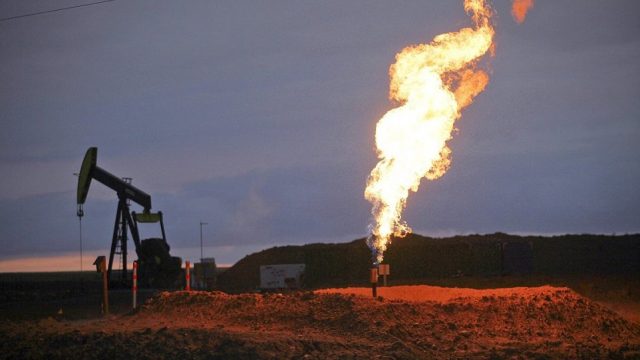The Real News Is That North Dakota Flaring Is Down Significantly

Reporter Amy Dalrymple caught North Dakota Petroleum Council President Ron Ness in a bit of an exaggeration about recent flaring reductions.
“North Dakota’s oil industry significantly reduced flaring last year, but whether it’s as substantial as an industry leader portrayed it in Fargo this week depends on how the decrease is calculated,” she reports.
It’s true that Ness was guilty of gilding the lily a bit on the numbers. In an address to an audience in Fargo/Moorhead he talked about a 64 percent decrease in the flaring percentage. He got there by comparing the current 13 percent flaring rate to the state’s historic high of 36 percent in February of 2014. Here’s the trend line he’s talking about, which is definitely impressive:
“I’ve always used the percentage basis because that’s what the targets have been set on and that’s the measuring stick,” Ness explained to Dalrymple. But, as Dalrymple points out, talking about the percentage reduction in the flaring percentage can be misleading because it doesn’t tell us much about the actual volume of gas being flared. The percentage of gas being flared can go down even as the total volume of gas flared goes up if the overall amount of gas being produced increases.
But what’s unfortunate is that Dalrymple made her story about Ness and his comments and not the fact that the volume of flaring is down significantly. Down more than 24 percent, in fact, over the last two years.
The flaring issue gets a lot of media coverage in the state, and rightfully so. It’s a subject worthy of public concern. But while increases in flaring get heavy media scrutiny, progress on flaring reductions do not.
As near as I can tell my post in mid-December after the most recent report from state oil and gas regulators was the only media mention of the fact that the volume of gas flared in the state has been on a sharp decline. Here’s that trend line for the last two years:
As near as I can tell neither Dalrymple nor any other reporter in the state has written a story about the significant and long-term and declining trend in gas flaring. That’s unfortunate given how much attention the media has give increases in flaring. And when Dalrymlpe does get around to mentioning declines in gas flaring, she puts it in the context of an industry spokesman exaggerating a bit.
Isn’t a 24 percent reduction in the volume of gas flared over the last two years news? It seems like news to me.
That’s too bad, though I should point out that this Dalrymple piece about the surging but often overlooked gas side of energy production in the state was really good.






